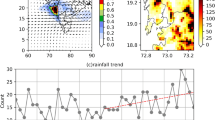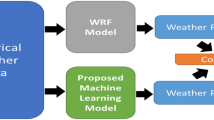Abstract
The aim of this study is to investigate the ability of different time series models in forecasting monthly rainfall. In order to do this, monthly rainfall data were collected from 9 rainfall stations in North Khorasan province (North east of Iran) from 1989 to 2012. R software was used to predict the highest rainfall in these 9 rain gage stations for the time period 2002–2012 using monthly highest rainfall data of 1989–2002. In this study, AR, MA, ARMA, ARIMA, and SARIMA with 11 different structures based on trial and error were examined. Because the trend, seasonal and jump components are deterministic components, it is not necessary to model these components, but modeling of random component is very important for rainfall forecasting. So, the main data series was decomposed (for AR, MA and ARMA models) and the random part has been modeled. After that, the random component was collected with the seasonal and trend component and the amount of rainfall was simulated. But for ARIMA and SARIMA, models fitted on original series. The result showed that in 33 % of data MA(2), in 22 % of data AR(1) and ARMA(2, 1) and in 11.11 % of data MA(1) and ARIMA(1, 1, 2) had the best performance in monthly rainfall forecasting. On the other hand, best time series model by change of data could vary. So, it is important to assess all the time series models for any area and any hydrological parameter.













Similar content being viewed by others
References
Adhikary SK, Mahidur Rahman MD, Das Gupta A (2012) A stochastic modelling technique for predicting groundwater table fluctuations with time series analysis. Int J Appl Sci Eng Res 1(2):238–249
Akrour N, Chazottes A, Mallet C, Barthes L (2014) Simulation of rainfall times series with zero values and realistic statistical distribution in a universal multifractal framework. Geophys Res Abstr 16:2014–6235
Behnia N, Rezaeian F (2015) Coupling wavelet transform with time series models to estimate groundwater level. Arab J Geosci 8(10):8441–8447
Box GEP, Jenkins GM, Reinsel GC (1994) Time series analysis: forecasting and control. Upper Saddle River, NJ
Bras RL, Rodriguez-Iturbe I (1985) Random functions and hydrology. Addison-Wesley, Reading, MA
Brockwell PJ, Davis RA (1996) Introduction to time series and forecasting. Springer, New York
Brockwell PJ, Davis RA (2010) Introduction to time series and forecasting. Springer, New York
Chatfield C (2001) Time-series forecasting. Chapman & Hall/CRC, New York
Delleur JW, Tao PC, Kavass ML (1976) An evaluation of practicality and complexity of some rainfall and runoff time series models. Water Resour Res 12:953–970
Durdu OF (2010) Application of linear stochastic models for drought forecasting in the Büyük Menderes river basin, western Turkey. Stoch Env Res Risk Assess 24(8):1145–1162
Dutta D, Wendy D, Welsh JV, Shaun SHK, Nicholls D (2012) A comparative evaluation of short-term stream flow forecasting using time series analysis and rainfall-runoff models in water source. Water Resour Manage 26:4397–4415. doi:10.1007/s11269-012-0151-9
Erdem E, Shi J (2011) ARMA based approaches for forecasting the tuple of wind speed and direction. Appl Energy 88(4):1405–1414
Faruk D (2010) A hybrid neural network and ARIMA model for water quality time series prediction. Eng Appl Artif Intell 23(4):586–594. doi:10.1016/j.engappai.2009.09.015
Feng Q, Wen X, Li J (2015) Wavelet analysis-support vector machine coupled models for monthly rainfall forecasting in arid regions. Water Resour Manage 29(4):1049–1065
Hannan EJ (1971) Multiple time series. Wiley, New York, p 536
Hipel KW, McLeod AE (1994) Time series modeling of water resources and environmental systems. Elsevier, Amsterdam
Hu Sh (2007) Akaike information criterion, enter for research in scientific computation. North Carolina State University, Raleigh, NC, p 19
Javidi Sabbaghian R, Sharifi MB (2009) Random modeling application in river flow simulation and estimation of mean annual river discharge by time series analysis. International conference on water resources (ICWR). Shahrood, Iran, August 15–17
Khadar Babu SK, Karthikeyan K, Ramanaiah MV, Ramanah D (2011) Prediction of rain-fall flow time series using auto-regressive models. Adv Appl Sci Res 2(2):128–133
Kim SJ, Hyun Y, Lee KK (2005) Time series modeling for evaluation of groundwater discharge rates into an urban subway system. Geosci J 9(1):15–22. doi:10.1007/BF02910550
Klose Ch, Pircher M, Sharma S (2004) Univariate time-series forecasting. 406347/UK “Ökonometrische Prognose” in SS04
Kumar Nanda S, Prasad Tripathy D, Kumar Nayak S, Mohapatra S (2013) Prediction of rainfall in India using Artificial Neural Network (ANN) models. Int J Intell Syst Appl 5(12):1–22. doi:10.5815/ijisa.2013.12.01
Kwon HH, Lall U, Khalil AF (2007) Stochastic simulation model for nonstationary time series using an autoregressive wavelet decomposition: applications to rainfall and temperature. Water Resour Res 43(5):1–15. doi:10.1029/2006WR005258
Lin GF, Lee FC (1992) An aggregation-disaggregation approach for hydrologic time series modelling. J Hydrol 138(3–4):543–557. doi:10.1016/0022-1694(92)90136-J
Mair A, Fares A (2011) Time series analysis of daily rainfall and streamflow in a volcanic dike-intruded aquifer system, O‘ahu, Hawai‘i, USA. Hydrogeol J 19:929–944. doi:10.1007/s10040-011-0740-3
Mansour MM, Barkwith A, Hughes AGN (2011) A simple overland flow calculation method for distributed groundwater recharge models. Hydrol Process 25(22):3462–3471. doi:10.1002/hyp.8074
Mirzavand M, Ghazavi R (2015) A stochastic modelling technique for groundwater level forecasting in an arid environment using time series methods. Water Resour Manage. doi:10.1007/s11269-014-0875-9
Mirzavand M, Sadatinejad SJ, Ghasemieh H, Imani R, Soleymani Motlagh M (2014) Prediction of ground water level in arid environment using a non-deterministic model. J Water Resour Prot 6:669–676. doi:10.4236/jwarp.2014.67064
Mondal MS, Wasimi SA (2007) Choice of model type in stochastic river hydrology hydrology. In: Proceedings of the 1st international conference on water and flood management (ICWFM), March 12–14, Dhaka, Bangladesh
Nirmala M, Sundaram SM (2010) Modeling and predicting the monthly rainfall in Tamilnadu as a seasonal multivariate ARIMA process. Int J Comput Eng Technol 1(1):103–111
Pebesma EJ, Switzer P, Loague K (2005) Error analysis for the evaluation of model performance: rainfall–runoff event time series data. Hydrol Process 19:1529–1548. doi:10.1002/hyp.5587
Poormohammadi S, Malekinezhad H, Poorshareyati R (2013) Comparison of ANN and time series appropriately in prediction of ground water table (case study: Bakhtegan basin). Water Soil Conserv 20(4):251–262
Radhakrishnan P, Dinesh S (2006) An alternative approach to characterize time series data: case study on Malaysian rainfall data. Chaos Solitons Fractals 27:511–518. doi:10.1016/j.chaos.2005.04.030
Saeidian Y, Ebadi H (2004) Determine the time series of data flow (case study: Vanyar station in the river basin Ajichai). 2nd Students conference on soil and water resources, Shiraz, Iran, May 12–13
Said SM, Manjang S, Wihardi Tjaronge M, Arsyad TM (2013) Arima application as an alternative method of rainfall forecasts in watershed of hydro power plant. Int J Comput Eng Res 3(9):68–73
Salas JD, Fernandez B (1993) Models for data generation in hydrology: univariates techniques. In: Macro JB, Harboe R, Salas JD (eds) Stochastic hydrology and its use in water resources systems simulation and optimization. NATO Advanced Study Institute, Kluwer Academic Publishers, Boston, pp 47–73
Schaars F, Von Asmuth DC (2012) Software for hydrogeologic time series analysis, interfacing data with physical insight. Environ Model Softw 38:178–190. doi:10.1016/j.envsoft.2012.06.003
Seed AW, Draper C, Srikanthan R, Menabde M (2000) A multiplicative broken-line model for time series of mean areal rainfall. Water Resour Res 36(8):2395–2399
Shamshirband Sh, Gocic M, Petkovi D, Saboohi H, Herawan T, Mat Kiah L, Akib Sh (2015) Soft-computing methodologies for precipitation estimation: a case study. IEEE J Select Top Appl Earth Obs Remote Sens 8(3):1353–1358. doi:10.1109/JSTARS.2014.2364075
Shirmohammadi B, Vafakhah M, Moosavi V, Moghaddamnia A (2013) Application of several data-driven techniques for predicting groundwater level. Water Resour Manag 27:419–432. doi:10.1007/s11269-012-0194-y
Silva MAP (2006) A time series model to predict the runoff ratio of catchments of the Kaluganga basin. J Natl Sci Found Sri Lanka 34(2):103–105. doi:10.4038/jnsfsr.v34i2.2089
Sokolnikov AN (2013) THZ identification for defense and security purposes identifying materials, substances and items. World Scientific Publishing CO.Pte. Ltd, Singapore
Soltani S, Modarres R, Eslamian SS (2007) The use of time series modeling for the determination of rainfall climates of Iran. Int J Climatol 27:819–829. doi:10.1002/joc.1427
Venkata Ramana R, Krishna B, Kumar SR, Pandey NG (2013) Monthly rainfall prediction using wavelet neural network analysis. Water Resour Manage 27(10):3697–3711. doi:10.1007/s11269-013-0374-4
Willems P (2009) A time series tool to support the multi-criteria performance evaluation of rainfall-runoff models. Environ Model Softw 24:311–321. doi:10.1016/j.envsoft.2008.09.005
Wu TN, Lee JY, Huang ChH (2010) Application of time series analysis on temporal variation of fluoride in groundwater around southern Taiwan science park. In: 7th international conference on Fuzzy Systems and Knowledge Discovery (FSKD), Yantai, China, August 10–12, 2010
Author information
Authors and Affiliations
Corresponding author
Rights and permissions
About this article
Cite this article
Dastorani, M., Mirzavand, M., Dastorani, M.T. et al. Comparative study among different time series models applied to monthly rainfall forecasting in semi-arid climate condition. Nat Hazards 81, 1811–1827 (2016). https://doi.org/10.1007/s11069-016-2163-x
Received:
Accepted:
Published:
Issue Date:
DOI: https://doi.org/10.1007/s11069-016-2163-x




